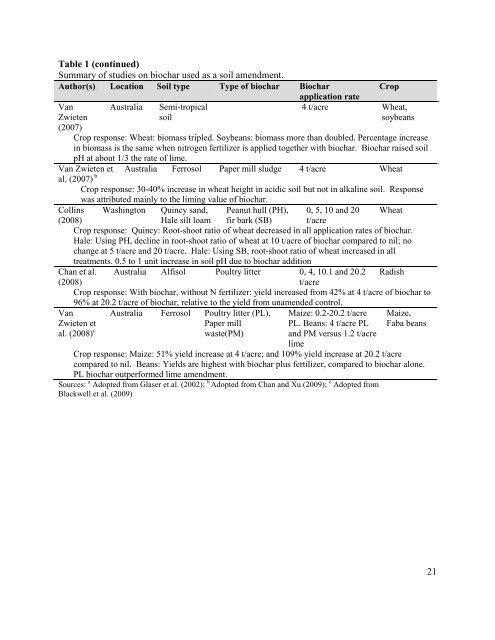The Economic Value of Biochar in Crop Production and Carbon ...
The Economic Value of Biochar in Crop Production and Carbon ...
The Economic Value of Biochar in Crop Production and Carbon ...
Create successful ePaper yourself
Turn your PDF publications into a flip-book with our unique Google optimized e-Paper software.
Table 1 (cont<strong>in</strong>ued)Summary <strong>of</strong> studies on biochar used as a soil amendment.Author(s) Location Soil type Type <strong>of</strong> biochar <strong>Biochar</strong>VanZwieten(2007)AustraliaSemi-tropicalsoil<strong>Crop</strong>application rate4 t/acre Wheat,soybeans<strong>Crop</strong> response: Wheat: biomass tripled. Soybeans: biomass more than doubled. Percentage <strong>in</strong>crease<strong>in</strong> biomass is the same when nitrogen fertilizer is applied together with biochar. <strong>Biochar</strong> raised soilpH at about 1/3 the rate <strong>of</strong> lime.Van Zwieten et Australia Ferrosol Paper mill sludge 4 t/acre Wheatal. (2007) b<strong>Crop</strong> response: 30-40% <strong>in</strong>crease <strong>in</strong> wheat height <strong>in</strong> acidic soil but not <strong>in</strong> alkal<strong>in</strong>e soil. Responsewas attributed ma<strong>in</strong>ly to the lim<strong>in</strong>g value <strong>of</strong> biochar.Coll<strong>in</strong>s(2008)Wash<strong>in</strong>gton Qu<strong>in</strong>cy s<strong>and</strong>, Peanut hull (PH), 0, 5, 10 <strong>and</strong> 20 WheatHale silt loam fir bark (SB) t/acre<strong>Crop</strong> response: Qu<strong>in</strong>cy: Root-shoot ratio <strong>of</strong> wheat decreased <strong>in</strong> all application rates <strong>of</strong> biochar.Hale: Us<strong>in</strong>g PH, decl<strong>in</strong>e <strong>in</strong> root-shoot ratio <strong>of</strong> wheat at 10 t/acre <strong>of</strong> biochar compared to nil; nochange at 5 t/acre <strong>and</strong> 20 t/acre. Hale: Us<strong>in</strong>g SB, root-shoot ratio <strong>of</strong> wheat <strong>in</strong>creased <strong>in</strong> alltreatments. 0.5 to 1 unit <strong>in</strong>crease <strong>in</strong> soil pH due to biochar additionAustralia Ferrosol Poultry litter (PL),Chan et al. Australia Alfisol Poultry litter 0, 4, 10.1 <strong>and</strong> 20.2 Radish(2008)t/acre<strong>Crop</strong> response: With biochar, without N fertilizer: yield <strong>in</strong>creased from 42% at 4 t/acre <strong>of</strong> biochar to96% at 20.2 t/acre <strong>of</strong> biochar, relative to the yield from unamended control.VanMaize: 0.2-20.2 t/acre Maize,al. (2008) c waste(PM)<strong>and</strong> PM versus 1.2 t/acreZwieten etPaper millPL. Beans: 4 t/acre PL Faba beanslime<strong>Crop</strong> response: Maize: 51% yield <strong>in</strong>crease at 4 t/acre; <strong>and</strong> 109% yield <strong>in</strong>crease at 20.2 t/acrecompared to nil. Beans: Yields are highest with biochar plus fertilizer, compared to biochar alone.PL biochar outperformed lime amendment.Sources: a Adopted from Glaser et al. (2002); b Adopted from Chan <strong>and</strong> Xu (2009); c Adopted fromBlackwell et al. (2009)21
















